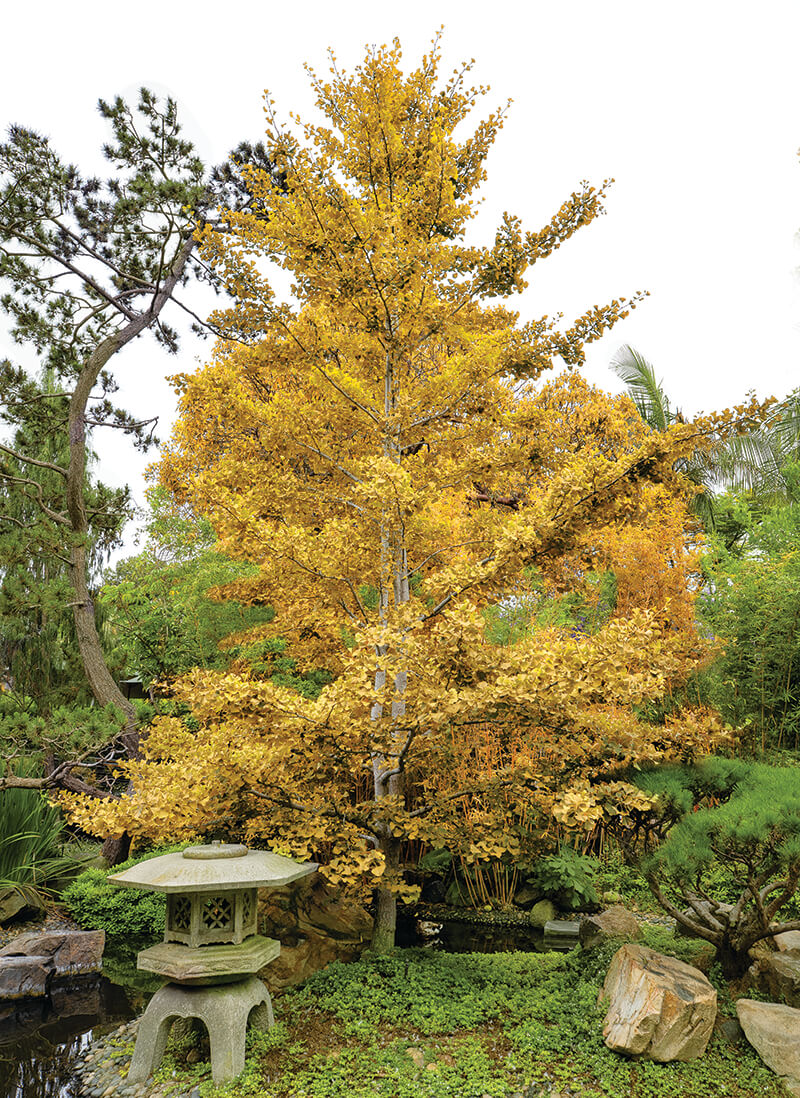BY Karyl Carmignani
Photo by Tammy Spratt
F all is a season packed with earth tones, comfort food, and nostalgia. The dog days of summer give way to crisp weather, honey-colored light, and a reminder that the only constant is change. Autumn is an invigorating buffer between swelter and snow! While fall may trigger a flurry of pumpkin-spiced everything and a countdown to “the holidays” for some people, other animals respond by storing food, producing antlers, migrating south, and growing more fur. Trees also buckle up for the onslaught of winter, with some putting on a brief but stunning show of color. While San Diego’s Mediterranean climate is better known for its leaves and flowers of spring and summer, there are still pockets of dramatic autumn colors. As French author Albert Camus rhapsodized, “Autumn is a second spring when every leaf is a flower.”

GOLDEN GLORY
A gingko tree Gingko biloba at the Zoo’s Terrace Lagoon shows off its dramatic fall color.
Cues and Hues
A utumn’s nickname “fall” is appropriate, as brittle leaves swirl to the ground in the slightest breeze. On deciduous trees, which tend to live in temperate, cold climates, each leaf is responding to an evolutionary effort to save the tree from the barbs and arrows of winter. Leaves are food-making receptors for the plant: green chlorophyll absorbs light energy and turns it into chemical energy through photosynthesis, fueling the tree. But in temperate regions, water flowing through the veins of leaves may freeze in winter, so shedding this liability is a useful strategy for the tree. And a pretty one!
At the base of each leaf is a layer of cells called the “abscission,” and as the days shorten and nights chill, the production of chlorophyll slows and eventually stops, revealing other pigments in the leaves. Carotenoids produce yellow, orange, and brown hues, as seen in aspens and hickories, among others. Other trees produce a pigment group call anthocyanins, which show off the reds and purples that oaks, dogwoods, and maples display.
Deciduous Decisions
During this burst of color, the abscission layer swells and becomes a perforated edge between leaf and tree, cutting off supply lines. Eventually the leaf drops, having served its purpose. But not all leaves fall for the same reasons. Some trees are semi-deciduous, essentially “molting” their leaves and growing them back quickly. Others, like the desert willow, are drought deciduous, shedding their leaves during the dry season. It’s an effective way to cope with environmental pressures.
 San Diego Zoo Global recently earned accreditation from Botanic Gardens Conservation International for its plant collections and plant conservation work. The San Diego Zoo has eight accredited collections, and the Safari Park has three accredited collections.
San Diego Zoo Global recently earned accreditation from Botanic Gardens Conservation International for its plant collections and plant conservation work. The San Diego Zoo has eight accredited collections, and the Safari Park has three accredited collections.
Autumnal Zoo and Park
T emperatures are more extreme at the Safari Park, so deciduous trees cast shade in summer and let sunshine in during winter. Robert Thurston, lead horticulturist, has worked at the Park since 1980, and has known many of its towering trees since they were humble seedlings. He takes great pride in his charges, declaring the Cape chestnut tree in Nairobi Village “ungodly beautiful” when in pink, spiky bloom, and it also cuts a handsome form without leaves. He shared some secrets of ginkgo trees, including different leaf shapes and the spectacular gold the leaves turn in autumn. His favorite tree is the wingnut tree, a member of the walnut family, named for its whirligig-shaped blooms. Found along Tull Family Tiger Trail, these are fast-growing trees and provide shade along the path, turning to tones of yellow in the fall.
There is also a cloak of color at the Zoo in autumn. Stephanie Shigematsu, curator of horticulture, spoke of deciduous trees like they’re old friends. “We like to inspire people about the wide range of trees here, and how they support our animal health and welfare goals.” She pointed to a Hong Kong orchid tree. “This is a semi-deciduous tree, losing its leaves sometimes—depends on its location and the weather—and we harvest its branches for primate browse.” A stroll around the koi pond reveals gingkos, crape myrtles, and three different types of Japanese maples, each hiding beautiful pigments beneath the chlorophyll, which emerge in the fall. At the first whiff of pumpkin spice, I’m returning to take in this colorful “second spring”!
(Top photo by: Shantell/iStock via Getty Images)





